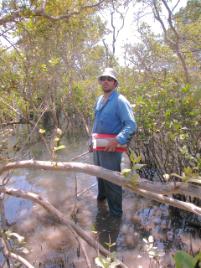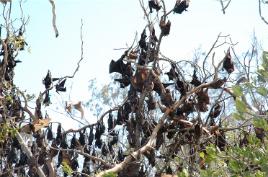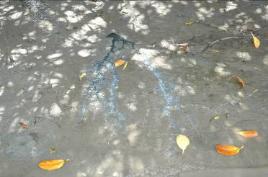Study checks links twixt flying foxes and fish
Published on 22 January, 2008
Flying fox guano may have a vital role in supercharging the food chain necessary for healthy fish stocks.
Yet little of detail is known about the impacts and sustainability of the process.

Dr Ralph Alquezar in the field
That's why Central Queensland University's Dr Ralph Alquezar is expanding his research into the effects of nutrient enrichment from flying fox guano on mangrove ecosystems on the coast.
He wonders if this boost of organic material can cascade up the food chain, boosting small organisms and providing sustenance for the small creatures which feed juvenile fish stocks.
Dr Alquezar will compare the results from mangrove sites near current and former flying fox roosting camps with sites away from camps within the Boyne River system.
One of the laboratory tests will use stable isotope analysis to trace food web relationships based on energy flows.
Stable isotope ratios will be determined in sediment samples using particulate organic matter, guano runoff in sediments, mangrove crabs and in common toadfish, a predatory fish species.
Dr Alquezar said his research would provide the basis for a number of further studies on estuarine ecosystem function.

Roosting colony of Grey Headed Flying Foxes at the Boyne River
"This study will help fill knowledge gaps in regard to nutrient transfer among intertidal food webs," he said.
"Understanding the effects of nutrient fluctuations and overall consequences to the surrounding environment is important in understanding ecosystem function".

Nutrient enriched Flying Fox guano oozing from a mangrove site at the Boyne River 
Dr Ralph Alquezar

